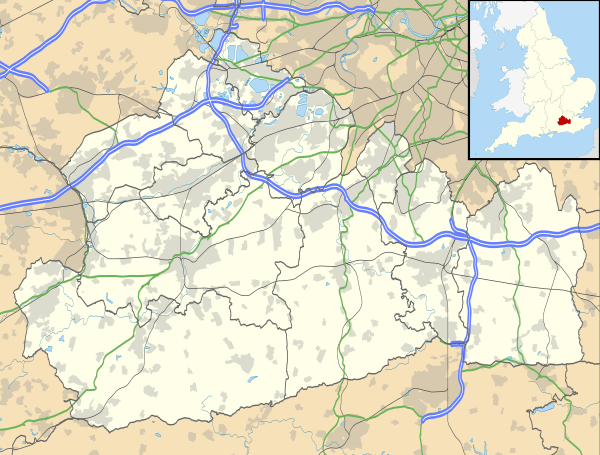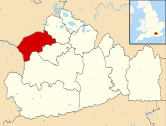Princess Royal Barracks, Deepcut
| Princess Royal Barracks, Deepcut | |
|---|---|
| Camberley, Surrey | |
|
Deepcut Camp | |
 Princess Royal Barracks, Deepcut Location within Surrey | |
| Coordinates | 51°18′16″N 00°41′57″W / 51.30444°N 0.69917°WCoordinates: 51°18′16″N 00°41′57″W / 51.30444°N 0.69917°W |
| Type | Barracks |
| Site information | |
| Owner | Ministry of Defence |
| Operator |
|
| Site history | |
| Built | 1900–1903 |
| Built for | War Office |
| In use | 1903-Present |
| Garrison information | |
| Occupants | Royal Logistics Corps |
The Princess Royal Barracks, Deepcut, commonly referred to as Deepcut Barracks, is the headquarters of the Royal Logistic Corps (RLC) of the British Army and the Defence College of Logistics, Policing and Administration. Located near Camberley, Surrey, England, it was the headquarters of the Royal Army Ordnance Corps until the formation of the RLC in 1993. At that time, it was known as Blackdown Barracks.
The barracks remain home to the RLC Museum, the Band of the RLC, The Defence Logistics School and 25 Training Support Regiment RLC, which trains the officers and soldiers in a range of logistical skills.
History
The area had been used as a training ground for the army from the late 19th century with no formal military infrastructure until 1900 when the Royal Engineers commenced the build of a number of camps, including Blackdown. The land was owned by the Pain family of Frimley Green who built a number of high status dwellings on the land.
Blackdown camp was established in the late 1903 initially to accommodate artillery and infantry, centred on Winchester house, renamed Blackdown House when it was appropriated by the War Office for military use. The barracks built in Blackdown Camp were Minden, Dettingen, Alma, Frith, Aisne and Marne Barracks. The Victorian houses were demolished in the 1950s, the land around Blackdown House being left to forestry, and around Dettingen House being redeveloped for a modernised Officers Mess. The site of Aisne and Marne Barracks were also re-developed and used for Military Family Housing. What remained of Frith Barracks were closed in the late 1970s and the land left to vegetation and used as a Military Training Area. Between 1967 and 1971 Minden Barracks was demolished and rebuilt as Blackdown Barracks (renamed Princess Royal Barracks after Anne, Princess Royal).[1]
The Barracks were the garrison of the Royal Army Ordnance Corps, and the School of Ordnance, until it merged into the Royal Logistic Corps in 1993. Dettingen and Alma Barracks have been closed and sold, and by 2002, demolished for housing development.[1]
In 2013, following the Defence Training Review and the merger of tri-service training to a single location, it was announced that the barracks were to close with the land being released for housing development.[2] The decision to sell the barracks had been announced in January 2008 by the then Armed Forces Minister Bob Ainsworth, who said that the sale would not take place before 2013.[3]
Defence College of Logistics
The Defence College of Logistics, Policing and Administration is responsible for training in logistics, policing and personal administration skills for the Royal Navy, Army and Royal Air Force officers and other ranks. The college has its headquarters at the Barracks with some specialist training taking place elsewhere, with access to special equipment or terrain.[4]
RLC Training
RLC personnel conduct their Phase 2 training at Deepcut, having completed Phase 1 training at an Army Training Regiment for soldiers or Royal Military Academy Sandhurst for Officers. All Officers undertake the RLC Troop Commanders Course prior to posting to a Regiment.
Soldier trainees specialise in a number of trades:
- Ammunition Technician
- Driver / Port Operator
- Seaman / Navigator
- Marine Engineer
- Supplier
- Chef
- Driver
- Driver / Radio Operator
- Driver / Air Despatcher
- Movement Controller
- Postal and Courier Operator
- Petroleum Operator
- Rail Operator
Officers may undertake specialist training as:
- Ammunition Technical Officer
- Port and Maritime Operations Officer
- Petroleum Officer
- Food Services Officer
- Postal and Courier Services Officer
Trainee deaths at Deepcut
Between 1995 and 2002 there were four deaths of trainees at the barracks which prompted families, the public and Ministry of Defence itself to call for investigation into any possible links, following four Coroner's commissioned investigations and inquests one producing a verdict of suicide by gunshot wounds, the other three returning open verdicts. This series prompted national media speculation.
On the 3 June 2016, a coroners report in to the death of Private Cheryl James in 1995, found that the death was "self-inflicted" and that Private James fired the gun intentionally.[5]
References
- 1 2 "Historical Pattern of Development" (PDF). Retrieved 5 April 2014.
- ↑ "Deepcut Barracks plan approved by councillors". Get Surrey. 19 July 2013. Retrieved 5 April 2014.
- ↑ "Timeline: Deaths at Deepcut". BBC News Online. 8 January 2008. Retrieved 1 February 2016.
- ↑ "Recruiting Selection and Training". Armed Forces. Retrieved 20 April 2014.
- ↑ http://www.bbc.co.uk/news/uk-england-surrey-36438786

